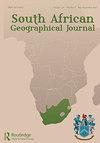南非大塞库库恩区lepelane集水区土地退化评估和测绘的三角测量方法
IF 1.4
4区 社会学
Q3 GEOGRAPHY
引用次数: 2
摘要
土地退化是一个复杂的环境问题,需要强有力的决策过程,包括当地土著知识的多样性。参与性方法对于了解土地退化过程的复杂性,同时克服忽视社会经济因素的科学方法所带来的限制至关重要。因此,三角测量方法可用于将参与式专家地图与卫星图像结合起来,通过叠加这两种地图来加强对土地退化的了解。这项研究通过专家评估纳入了导致土地退化的社会和物理因素。这是通过一项参与性专家绘图工作实现的,这项工作使用了世界概览保护方法和技术(WOCAT)绘图调查表和遥感技术来绘制土地退化严重程度,这些严重程度是通过覆盖,即三角测量方法综合起来的。WOCAT的结果通过实地观测和对土地覆盖的讨论得到了验证。气候变化、不当的土壤管理和不可持续的土地使用做法被确定为土地退化的主要原因,而土壤侵蚀和植被覆盖的丧失被认为是土地退化的主要类型。利用土地退化严重程度模型估算裸露土壤覆盖度的准确度R2为0.86,RMSE为7.72,relRMSE为12.94%,可作为潜在土地退化严重程度的指标。叶面积指数(LAI)和土壤调整植被指数(SAVI)是确定退化景观的重要变量。严重程度图显示,由于过度放牧,低洼地区处于中度退化状态。该研究的结论是,三角测量方法可以更好地了解土地退化。本文章由计算机程序翻译,如有差异,请以英文原文为准。
A triangulation approach for assessing and mapping land degradation in the Lepellane catchment of the greater Sekhukhune District, South Africa
ABSTRACT Land degradation is a complex environmental problem that requires robust decision-making processes that embrace diversity of local indigenous knowledge. Participatory approaches are essential in capturing the complexity in land degradation processes while overcoming limitations presented by scientific methods that disregard socio-economic factors. Hence, the triangulation approach can be used to combine participatory expert maps with satellite imagery by overlaying both maps to enhance understanding of land degradation. This study incorporated social and physical factors that cause land degradation through an expert assessment. This was achieved through a participatory expert mapping exercise using the World Overview Conservation Approaches and Technology (WOCAT) mapping questionnaire and remote sensing techniques to map land degradation severity that was integrated by overlaying, i.e. triangulation approach. The WOCAT results were validated using field observations and discussions on land covers. Climatic variability, improper soil management and unsustainable land-use practices were identified as leading causes of land degradation while soil erosion and loss of vegetation cover were the perceived prominent types of land degradation. The land degradation severity modelling assessment achieved an accuracy of R2 0.86, RMSE 7.72 and relRMSE 12.94% in estimating bare soil cover, which was used as an indicator of potential land degradation severity. Variables such as leaf area index (LAI) and soil adjusted vegetation index (SAVI) were essential in determining degraded landscapes. The severity maps indicated that low-lying areas are moderately degraded due to overgrazing. The study concluded that a triangulation approach provides a better understanding of land degradation.
求助全文
通过发布文献求助,成功后即可免费获取论文全文。
去求助
来源期刊

South African Geographical Journal
GEOGRAPHY-
CiteScore
3.40
自引率
7.10%
发文量
25
期刊介绍:
The South African Geographical Journal was founded in 1917 and is the flagship journal of the Society of South African Geographers. The journal aims at using southern Africa as a region from, and through, which to communicate geographic knowledge and to engage with issues and themes relevant to the discipline. The journal is a forum for papers of a high academic quality and welcomes papers dealing with philosophical and methodological issues and topics of an international scope that are significant for the region and the African continent, including: Climate change Environmental studies Development Governance and policy Physical and urban Geography Human Geography Sustainability Tourism GIS and remote sensing
 求助内容:
求助内容: 应助结果提醒方式:
应助结果提醒方式:


